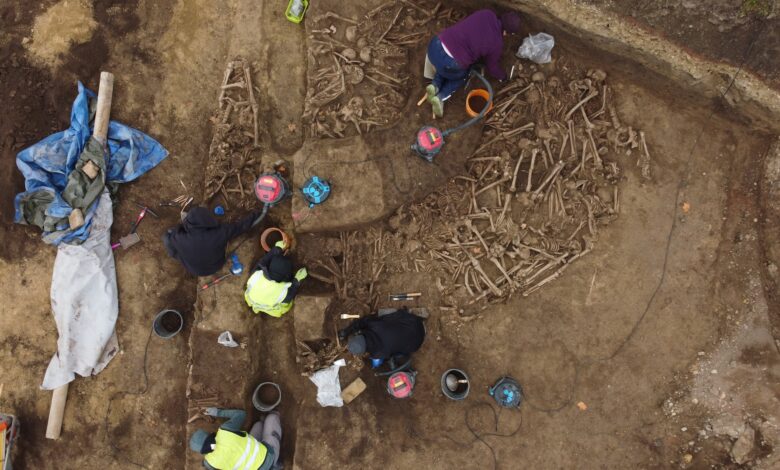Mass grave of over 120 Roman soldiers found under soccer field

The recent renovation of a soccer field near Vienna, Austria has led to a significant archeological discovery: a mass grave dating back to the first century CE during the Roman empire. The gravesite contained the skeletons of potentially over 150 soldiers, shedding light on life on the Roman frontier at the peak of the empire’s power.
Vienna, a city with a rich history, traces its roots back to Rome’s forces establishing military outposts in present-day Austria around 2,000 years ago. One of the largest garrisons was Vindobona on the Danube River, which grew to be home to thousands of residents. The Roman forces eventually left Vindobona to the Huns in 433 CE, leading to the abandonment of the outpost for centuries. Despite historical accounts of combat in the region, there was no direct evidence until now.
In October 2024, a construction team working on a soccer field in the town of Simmerling near Vienna discovered a mass grave of at least 129 individuals, likely Roman legionnaires aged between 20 and 30 years old. Archeologists confirmed that the skeletons showed signs of fatal battle injuries from weapons like spears, swords, daggers, and bolts.
The discovery was surprising as Romans typically cremated bodies instead of burying them, making inhumations like this a rare find. Kristina Adler-Wölfl, Vienna’s head of archeology, highlighted the significance of the discovery, stating that finds of Roman skeletons from this period are extremely uncommon. This mass grave may provide new insights into Roman warfare practices and burial rituals of the time.
Historical accounts mention battles between Roman forces and Germanic tribes along the Danube border during Emperor Domitian’s reign, prompting Emperor Trajan to expand the Vindabona fortification borders, known as the Danube Limes. Archeologist Martin Mosser believes the mass grave in Simmerling is the first physical evidence of fighting during this period, indicating a battle in the area of present-day Vienna.
Further excavations and analyses, including DNA and isotopic studies, are planned to better understand the warriors’ living conditions and expand our knowledge of Roman history in the first century. This unique discovery has the potential to enhance our understanding of ancient combat practices and provide valuable insights into life on the Roman frontier during the height of the empire’s power. Vienna, the capital city of Austria, has a rich history that dates back to Roman times. The city was originally known as Vindobona, a Roman military camp that was established in the 1st century AD. The foundation stone of Vienna, as we know it today, was laid by the Romans when they built Vindobona.
Vindobona played a crucial role in the development of the city. It served as a strategic military outpost and trading hub, connecting the Roman Empire to the rest of Europe. The Romans built fortifications, roads, and buildings in Vindobona, laying the groundwork for the city’s future growth and development.
Over the centuries, Vienna evolved into a thriving cultural and economic center. The legacy of Vindobona can still be seen in the city’s architecture, with remnants of Roman ruins scattered throughout Vienna. The Roman influence is also evident in Vienna’s cultural traditions, such as its classical music heritage and coffeehouse culture.
Today, Vienna is a vibrant and cosmopolitan city that attracts millions of visitors each year. From its grand palaces and museums to its bustling markets and trendy cafes, Vienna offers a unique blend of history and modernity. The city’s rich past, rooted in the foundations laid by Vindobona, continues to shape its identity and character.
As we walk the streets of Vienna, we can’t help but marvel at the legacy of Vindobona and the role it played in shaping the city we know and love today. The Romans may have long departed, but their imprint on Vienna remains, a testament to the enduring influence of the past on the present. Vienna truly is a city where history comes alive, thanks to the humble foundation stone laid by Vindobona centuries ago.





